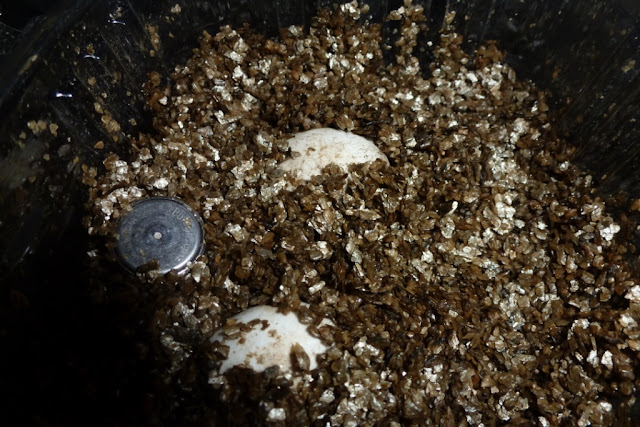Two terrapins from the clutch laid in June the 11th have hatched. These two eggs were incubated at high temperature, nearly 30ºC. The first one was born on July the 25th and the second one the 26th. This last one corresponds to the egg that deformed a little bit some days ago.
According to the book "Turtles of the United States and Canada" the natural incubation usually lasts 50-90 days, although in captivity it can take only 44 days. With mine, it has been 45 and 46 days.
They are usually born with a spot in each scute except the first cervical that has none. This is what happened with last year hatchling, incubated at lower temperature and probably lower humidity. This time both terrapins have more than one spot in some scutes.
 |
| The first hatchling |
 |
| The same animal |
 |
.JPG) |
| The "egg tooth" |
 |
| The second terrapin peeping from inside the egg |
 |
| The second hatchling |
I put them in humid paper until they absorbed the viteline sac (around 28 hours). I already keep them outdoors, in a fiberglass tank with little water and a plant in the middle. The terrapins hide under the roots and the algae. There are some mosquito larvae that will hopefully be their first food.
I haven't put them with their brother born in 2011. I don't trust him, he is bigger and those long tails could be confused with food.
I now realize how much has last year's hatchling grown in a year
 |
| When they are born the spots are not yellow. |
 |
| It is easy to see the growth in the shields |
It didn't take the food that I offered him until this last spring. Then it only ate earthworms, insects... One day he tasted the pudding and now he eats it as well.
.JPG) |
With this size he begins to behave like the adults, sunbathing on a log. I didn't see him doing it when he was smaller. In spite of this he is still very shy. When he sees me, he drops to the water and hides under the vegetation.
The adults relate me with the food. They swim away if I am too close but they keep an eye on me, just in case I throw some food. The hatchling doesn't relate me with food yet and stays hidden.
.JPG)

















